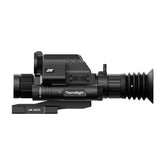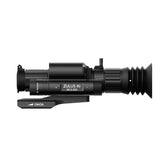Night Hunting with DNT Optics in Your State
Hunting at night is a fun and unique experience that is different from daytime hunting. There are challenges with hunting at night that you should be aware of and plan for if you intend to hunt at night. DNT optics scopes can help with some of those challenges.

Know Your Local Regulations
Before we get started talking about gear, we want to preface this with “Know your local rules and regulations.” As you may know, with standardized hunting, there is a minefield of rules and regulations set by your local Game Commission. It is in your best interest to know what you can hunt and what you can use while hunting. Some states do not allow the use of night vision, thermal or artificial light and in some cases they do not allow night hunting at all. Trying to get a straight answer from someone online is not going to help you as some information can be anecdotal or just plain wrong. It is best to talk to an official game warden or try to navigate the myriad of rules and regulations they have set in place for the game animal you are hunting.
For many states, it is legal to hunt nuisance animals like wild hogs and coyotes. They tend to damage property like when hogs dig up a farmer's land or coyotes killing and eating farmers’ animals. Take Nevada for example. Night hunting is strictly forbidden. However, that is in the context of game animals. Depending on what county you are in, you can hunt coyotes with night vision and thermal.
Choosing Your Technology: Thermal vs. Night Vision
If you want to legally hunt animals at night, what technology should you get? Well, that depends on the environment you are hunting in.
The Thermal Advantage: Unmatched Detection
Thermal has become the main choice for hunters as it allows you to detect animals even if they are partially hidden behind vegetation. It is very difficult for animals to hide from Thermal. Thermal is 100% passive. It does not emit any light except for those scopes that have built-in laser rangefinders (LRF). Our HYDRA multi-function scopes are perfect for this. But for those who want to use our new HYDRA-LRF scopes, know that LRFs emit a laser in the near infrared (NIR) wavelength.

The IR laser technically emits light and some states consider this “artificial light”, while this is not the same as “spotlighting” where hunters would use bright lights to shine at animals which causes the animals to stop and stare at the light. However, many Game Commissions consider all light as a potential violation. This leads into using night vision for hunting.
The Night Vision Advantage: Superior Resolution and Identification
DNT Optics ZULUS digital scopes have digital night vision and while they can see at night, they require the use of the built-in IR illuminator. For those who live and hunt in states that ban the use of illuminators, we make an IR delete cap. Just know that the non-LRF models of ZULUS V1 do not have the ability to remove the IR illuminator. You need to buy a ZULUS V1 with LRF, ZULUS V2 or ThermNight.
Why would you want to use night vision instead of thermal? Resolution. The resolution of night vision, even digital night vision, is higher than thermal. Even with the best thermal money can buy, there are limitations to what thermal can see. See the video below. It is a deer 609 yards away observed with a DNT ThermNight TNC335R, a multispectral scope that combines both thermal and digital night vision capabilities. The thermal channel was able to detect the heat signature, and based on its movement and basic shape, you can recognize it is probably a deer. However, it is only until we turned on the IR Illuminator and look at the deer under digital night vision channel do we see it is a buck with antlers on its head.
This is where night vision can beat thermal. You can see farther and more clearly that thermal provided you have the right lighting. In the video, you can see there are some weeds in front of the observer. If the IR illuminator onboard the TNC335R had been turned on, those same weeds would splash the IR light back at the digital sensor, making it difficult to see past them. Think of your car driving in heavy rain or fog and you turn on your high beams, can you see the road or do you just see rain or fog? This is why the observer told Matt to turn on his illuminator which also happened to be another TNC335R.
Having positive identification of a potential target is crucial. You do not want to hunt the wrong animal and be in violation of the Game Commission. Even if you were able to legally hunt deer at night, there are some instances where you are only allowed to hunt does and not bucks. In the case of coyote hunting, you need to know you are looking at a coyote and not someone’s pet dog out on the loose.
The Game-Changer: Laser Rangefinders for Thermal Hunting
One tool that has been immensely helpful when hunting at night is the LRF, especially with thermal. While night vision can see more detail further than thermal, it only works if the lighting works for you. If it is dusty or there is vegetation between you and your target, it may be difficult to see it clearly with digital night vision. However, thermal does not rely on light to see. So in many cases, it can detect heat signatures at greater distances than digital night vision at night. It is often difficult to gauge distances with thermal unless you are in an environment that you know very well and know the distances of certain landmarks.

But when you see distant, heat signatures will only show up as blobs of heat. So knowing how far that blob of heat is can tell you a lot when you use an LRF. Through experience you can recognize the average shapes of animals like cows. Cows are a lot larger than coyote or pigs. So if you see a blob and you range it with the LRF, how far it is can tell you a lot. If it is close, then it is a small blob up close that appears bigger than you think; otherwise, it is a large blob far away. Cows show up very well under thermal and sometimes can be confused for pigs if you do not know how far they are. Both animals often have their heads down, looking for or eating food. So an LRF is a fantastic tool to use with thermal hunting.
Conclusion: Hunt Legal, Hunt Smart
Night hunting is a lot of fun and can be helpful for many if you are helping to prevent or stop property damage. Just make sure you do your research and make sure you are in compliance with all local rules and regulations. If you are not sure, try contacting your local game warden.
For gear choice, HYDRA offers powerful thermal imaging capabilities, ZULUS delivers high-resolution digital night vision, and ThermNight combines both with an integrated LRF for precise ranging and all-condition performance. Choose what fits your needs best. Hunt smart and have fun.







